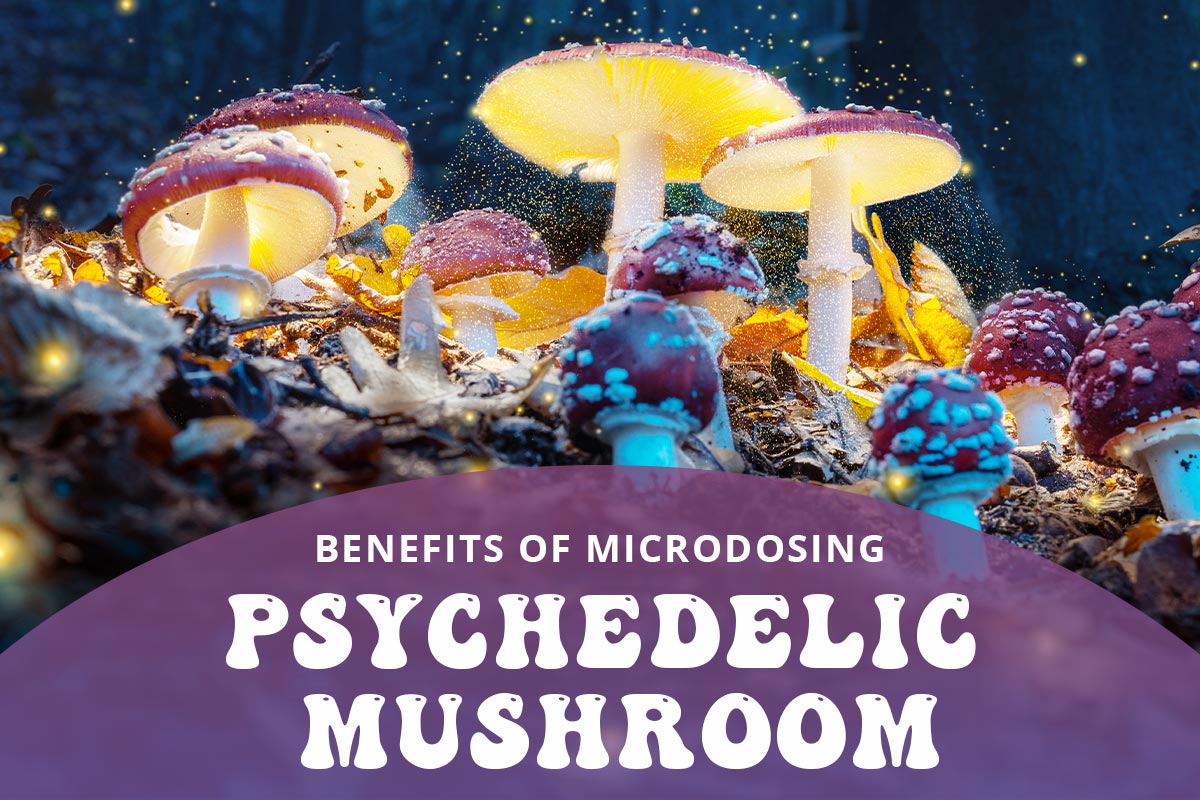What does it mean to microdose mushrooms?
Microdosing mushrooms is the act of consuming a very small amount of dried mushrooms, typically 1/20th of a regular dose of psilocybin. Psilocybin, the main active compound in psychedelic mushrooms, is a psychedelic substance that can produce powerful hallucinations. Microdosing mushrooms can produce some of the same effects as a regular dose but at a much lower intensity. Many people who microdose say that it feels like a milder version of taking a normal dose of the drug. Some microdosers have also reported feeling more alert and clearheaded, while others say they feel more calm and relaxed.
In some cases, microdosing can cause mild visual and auditory hallucinations. This makes it an attractive option for people who want to experience the benefits of psychedelics without strong hallucinations. Microdosing and the benefits of psychedelic drugs have both gained popularity in recent years with many clinical trials underway to study their potential therapeutic benefits.
What is a Psychedelic?
Psychedelics are substances that can alter perception and cause changes in thought, emotion, and behavior. They include natural compounds like psilocybin, which is found in some mushrooms, as well as synthetic drugs like LSD.
Psychedelics are sometimes used for therapeutic purposes, such as in the treatment of post-traumatic stress disorder. They can also be used recreationally, often for the purpose of achieving an altered state of consciousness.
Psychedelics are believed to work by binding to serotonin receptors in the brain. This can lead to changes in brain activity and neurotransmitter release. These changes can result in altered perceptions, emotions, and thoughts.
Psychedelics are not considered addictive and there is no evidence that they are harmful when used responsibly. However, they can cause adverse reactions in some people, so it is important to be aware of the potential risks before using them.
How Psilocybin works its “magic” in the brain
The brain is an amazing thing. It’s the control center for everything we do, think and feel. It’s also responsible for some pretty incredible feats, like keeping our heart beating and our lungs breathing. So it’s no surprise that when we mess with it, things can get pretty interesting.
That’s what happens when we take psilocybin, a psychedelic drug found in magic mushrooms. When we ingest psilocybin, it breaks down into a compound called psilocin, which binds to receptors in the brain that are responsible for regulating serotonin. Serotonin is a neurotransmitter that plays a role in mood, perception and cognition.
Psilocin alters serotonin signaling, which can lead to changes in mood, perception and cognition. That’s why people who take psilocybin often report feeling more relaxed, happy and open-minded. They may also experience visual and auditory hallucinations.
What to know before microdosing
If you’re considering microdosing, it’s important to know that the effects can vary depending on the person and the dosage. Before microdosing, it’s important to know what dose you’ll be taking. Start with a very small dose and increase gradually until you find the dose that works best for you.
It’s also important to know what psychedelic substance you’ll be taking. Psilocybin is the most common psychedelic used for microdosing. Other psychedelics, such as LSD, can also be used, but they come with different risks. The effects of microdosing vary so it’s still worth trying if you’re interested in the potential benefits.
Can microdosing mushrooms reduce anxiety, depression, and stress?
There is some evidence to suggest that microdosing can help to reduce anxiety, depression, and stress. For example, a study published in the Journal of Psychopharmacology found that psilocybin (the active ingredient in magic mushrooms) can help to reduce symptoms of PTSD. Other research has shown that psilocybin can help to reduce levels of anxiety and depression, and can also help to improve coping mechanisms for stress. While more research is needed in this area, there is promise that mushrooms could be an effective way to reduce these mental health issues.
Psilocybin, the active ingredient in mushrooms, acts on the brain to change neural pathways. This can help to break the cycle of negative thinking that can lead to anxiety and depression. PTSD sufferers have also found relief from microdosing psilocybin and LSD. The changes in brain chemistry caused by psilocybin can help to reduce the symptoms of PTSD.
What is a typical microdosing schedule?
A typical microdosing schedule involves taking a very small dose of a psychedelic drug on a regular basis. This could be once every few days or even every day. The idea is that by taking such a small dose, you can avoid any negative effects while still experiencing the positive benefits of the drug.
Psychedelic microdosing has become popular in recent years as more people are looking for natural ways to improve their health and wellness and psilocybin may help enhance overall mood and well-being. Microdosing may help increase creativity, focus, and feelings of well-being, while also reducing stress and anxiety.
The effects of a microdose typically last for four to six hours. Some people may feel the effects of a microdose a bit longer with users reporting the effects lasting for up to 12 hours.
Are there risks to microdosing psychedelics?
There are always risks associated with taking any kind of drug, even in small doses. Microdosing can cause negative side effects like anxiety, paranoia, and hallucinations. It can be difficult to control the amount of psilocybin you’re taking when microdosing, which can lead to accidentally taking too much and experiencing more intense effects.
Are psychedelics legal in some states?
Psychedelics are powerful substances that can alter your perception, emotions, and thoughts. Psychedelics can be both natural or synthetic. Natural psychedelics include ayahuasca, psilocybin, and mescaline. Synthetic psychedelics include LSD, MDMA, and ketamine.
Psychedelics are legal in some states for therapeutic use. However, they are not legal in all states. Psychedelics are not currently legal at the federal level in the United States.
Psychedelics are a class of drugs that produce powerful changes in perception and mood. They can cause hallucinations, distort time, space, and alter your overall sense of self. Psychedelics are illegal in most countries, but some states have decriminalized them for personal use. In the United States, psychedelics are classified as Schedule I drugs, which means they have a high potential for abuse and no accepted medical use. Despite their legal status, psychedelics are sometimes used for religious or spiritual purposes.
There is also a risk of developing tolerance to the drug, which means that you will need to increase the dose to feel the same effects. Finally, there is a risk of addiction and dependence with any drug use, including microdosing.
To microdose or not to microdose?
Psychedelics, such as psilocybin have long been associated with counterculture and illegal activities. However, recent studies have shown that psychedelics can have significant benefits for mental health.
Microdosing, or taking a small dose of a psychedelic drug, has been shown to improve mood and reduce anxiety. Psychedelics are also being studied as a potential treatment for addiction and post-traumatic stress disorder. Despite the promising research, the stigma around psychedelics remains.
There is anecdotal evidence that microdosing can be beneficial and help improve mood, creativity, focus, and energy levels. Some people report feeling more productive and creative after microdosing, while others find that it helps them to feel more relaxed and in the moment. However, there is no guarantee that microdosing will work for everyone as the effects may vary from person to person.
Additionally, there are some risks associated with microdosing, such as accidentally taking too much of the substance or having a bad reaction to it. Therefore, it is important to weigh the pros and cons before deciding whether or not to microdose.

